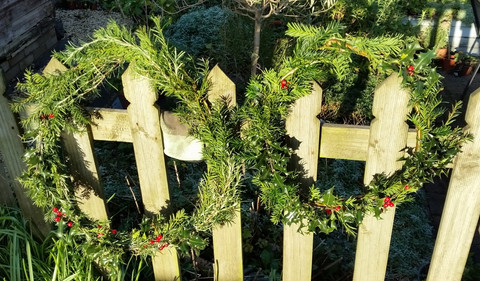Decorating for Christmas
- Clare
- Nov 28, 2020
- 4 min read
November is a month for the senses and a time of extremes. There is an ever-present smell of smoke pervading the air as households start to light their wood burners and gardeners have their annual clear out. Carpets of colourful leaves crunch underfoot and cobwebs sparkle in the autumn sunshine.
In the quiet of the early morning, the garden seems so still and peaceful, often covered with a blanket of thick fog or frost. Then, suddenly, everything wakes up and there is constant chatter as birds fly hither and thither collecting spiders or berries and seeds. We had a very excitable group of long tailed tits in the garden this week which were noisily flying between the shrubs and remaining seed heads. They are such pretty little birds which are typically less than half the weight of a robin (their small size can lead them to huddle together at night to keep warm).

The ducks also visit the garden regularly looking for food. Sadly, we have not seen the ducklings for some time and fear that they may all have fallen victim to aggressive adults or the ever-present red kites that circle over-head. The reintroduction of red kites to the area has been very successful but has caused some controversy. Typically feeding on carrion, the increase in kite numbers and the propensity of people to feed them in gardens, has led hungry birds to take food from people's hands and to attack small birds such as ducklings.
The weather yesterday was cold and foggy when Andy and I wandered down to the allotment to do a bit of autumn clearing and digging before the frosts properly set in. It was a beautiful still morning and one of those days when the fog never seems to fully lift, though stopping to admire the view would have meant getting cold so we found ourselves completing the job in record time and it was nice to get back to the warmth of a cosy cottage. Our old cat Tilly is clearly of the same view and has hardly left this spot by the radiator over the past few days.

Fortunately, the weather was kinder earlier in the week and we enjoyed some beautiful blue skies and autumn sunshine when we made our Christmas wreaths last weekend. The finished wreaths were certainly rustic, but we really did enjoy the process of making them.
We used willow branches, secured with garden wire, to make a circular base and then foraged in the garden for greenery to decorate with. We used yew, holly, rosemary and lavender, though other evergreen plants such as bay, ivy or pine would have worked equally well. Half the fun of the process is foraging for suitable materials and then unleashing your creative juices to make something from nothing! You could also add ribbon, pine cones, or dried orange slices for decoration if the mood takes you.
Andy also used some yew branches to make a lovely garland for our picket fence:

The long-living Yew is often used as an alternative to more traditional Christmas tree varieties and its thick, evergreen branches can make beautiful Christmas decorations. Whilst it is now widely used as dense hedging or for ornamental purposes, Yew wood was once valued highly as a material with which to make long bows and cross bows. As the berries are poisonous to livestock, the tree was often grown in churchyards (where it is frequently still seen today), where the branches could also be used in Palm Sunday services. Yews are probably the longest living species of tree in Northern Europe and some examples are believed to be over 2,000 years old. It is hardly surprising that the tree was sacred to the Druids and symbolised life and resurrection to Christians.
The Woodland Trust lists some of the oldest Yew specimens in the country, such as the Ankerwycke Yew in Berkshire which could be as old as 2,500 years. There are tales of King Henry VIII proposing to Anne Boleyn under this tree, and the Magna Carta being sealed in its shadow. Whilst these tales may not be true, the fact that the tree is old enough for them to be possible, is truly remarkable.
As 28th November to 6th December marks National Tree Week, it is a great time to visit trees which have a special story, or simply to take a stroll around one of our woodlands. If you are looking for inspiration, BBC Earth lists some of Britain's most legendary trees, whilst the National Trust provides ideas of signs to look for during a woodland walk:
Excerpt from "Yew-Trees"
There is a Yew-tree, pride of Lorton Vale,
Which to this day stands single, in the midst
Of its own darkness, as it stood of yore:
Not loathe to furnish weapons for the Bands
Of Umfraville or Percy ere they marched
To Scotland's heaths; or those that crossed the sea
And drew their sounding bows at Azincour,
Perhaps at earlier Crecy, or Poictiers.
Of vast circumference and gloom profound
This solitary Tree! -a living thing
Produced too slowly ever to decay;
Of form and aspect too magnificent
To be destroyed.
William Wordsworth
Excerpt from The Canterville Ghost
"Far away beyond the pine-woods", he answered, in a low dreamy voice, "there is a little garden. There the grass grows long and deep, there are the great white stars of the hemlock flower, there the nightingale sings all night long. All night long he sings, and the cold, crystal moon looks down, and the yew-tree spreads out its giant arms over the sleepers". Oscar Wilde























Comments